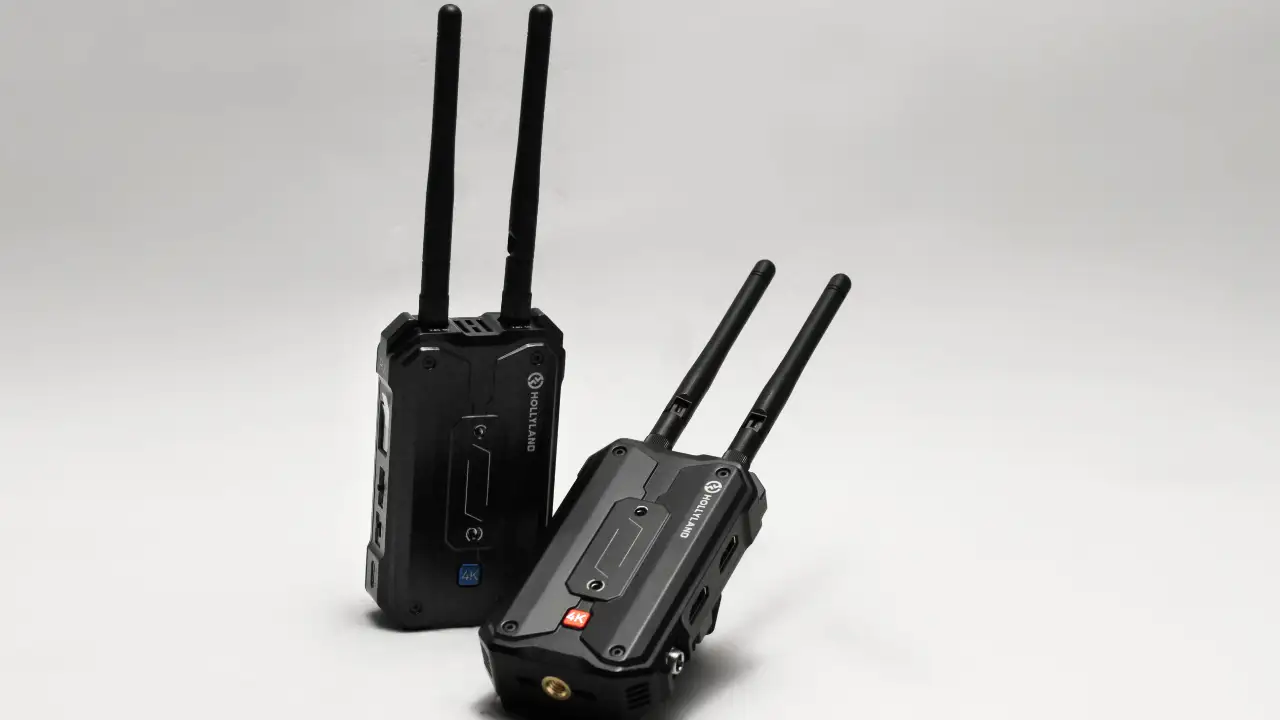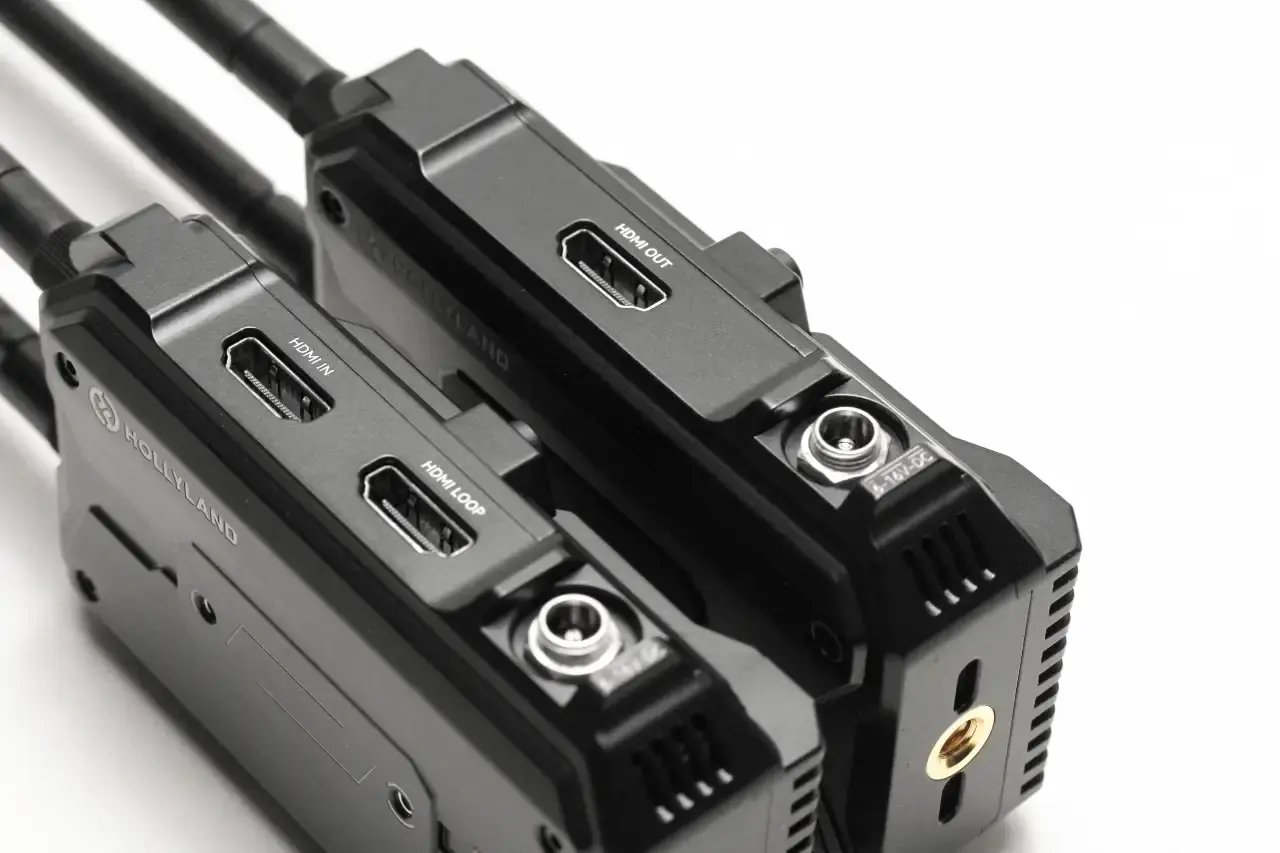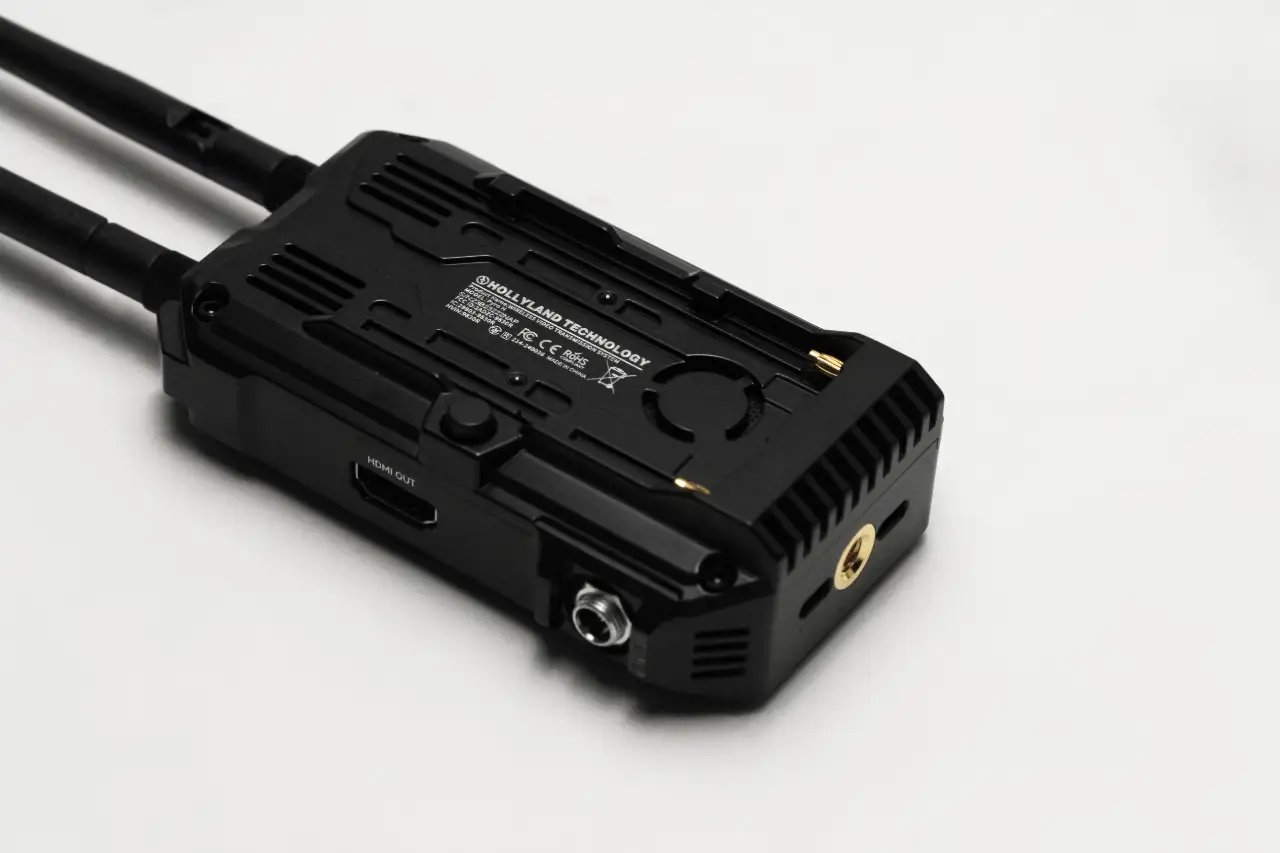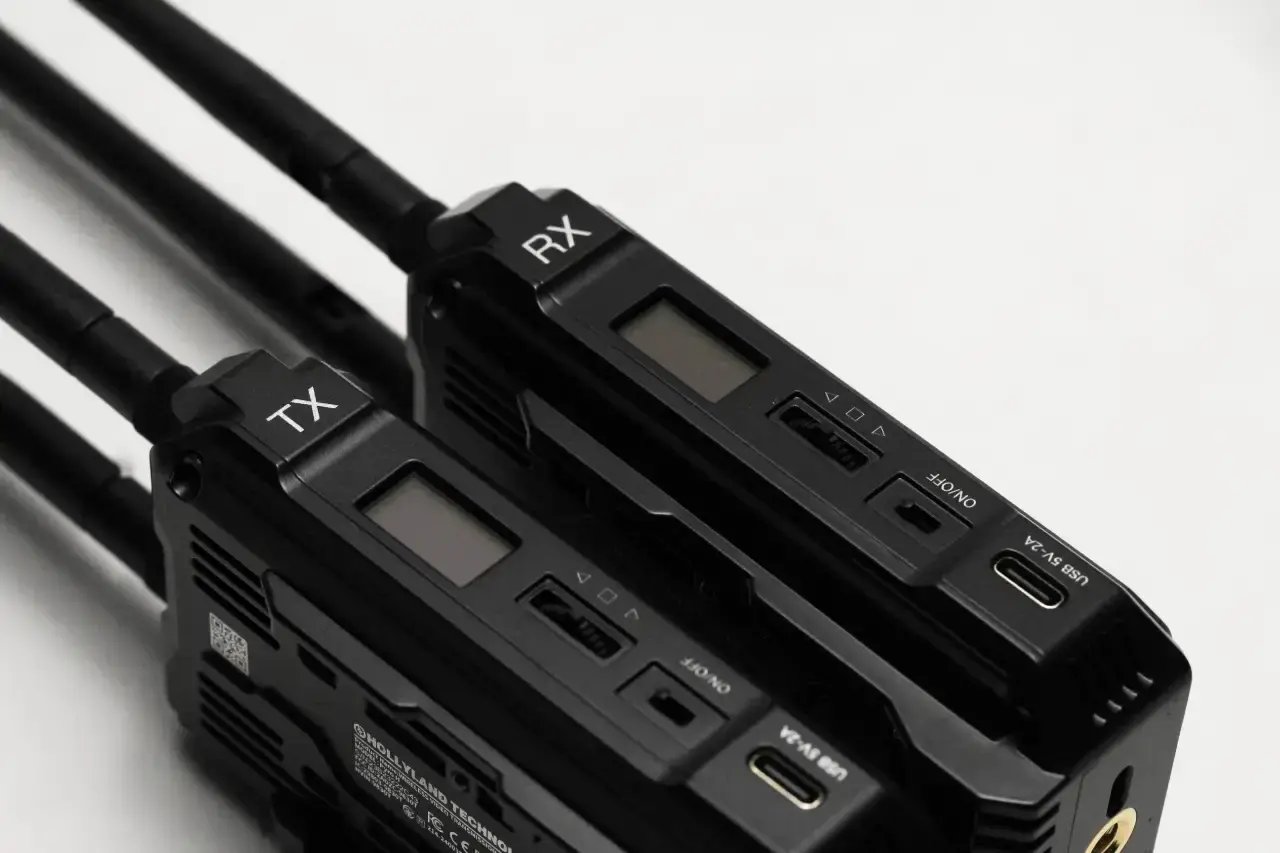
Phil Rhodes puts the new Hollyland Pyro H video link though its paces and find a tool aimed at people with rigged-up mirrorless cameras who need to travel light and move fast.
Manufacturers seem perpetually engaged in packing ever more functionality into ever-smaller boxes. That’s something Hollyland has been enthusiastically doing for a while. The new Hollyland Pyro H video link is a case in point. This is the HDMI-only option in the Pyro line, clearly aimed at the indie-filmmaker end of the market, people with rigged-up mirrorless cameras and a need to travel light and move fast. It lets us send 30-frame UHD to four devices, which might include Pyro receivers or WiFi clients, and the USB output lets us feed a laptop to create a streaming setup.
Different orientations
Unusually, the -H has a very different layout than the SDI-capable Pyro S. Both devices have similar specifications as radio links, but the H-suffix is a vertically-oriented package with two antennae, while the -S is horizontal, with three. It’s always hard to talk about radio reliability, being so dependent on the moment-to-moment environment, but whether or not this is a true diversity receiver, more antennae is no bad thing.

For SDI, you need the Pyro S, which is in a rather different form factor - horizontal, with three antennae
The HDMI connector seems like the physically feeblest part. There’s not much Hollyland can do about that – it is what it is - but the selection of a threaded DC connector and cast metal overall construction makes for an otherwise sturdy feel. Other power options include the USB-C connector itself or NP-F style batteries. Hollyland sensibly suggests that the USB-C is good for use on gimbals, where it’s becoming a de facto standard.
Does anyone make a back-to-back NP-F plate with a power connector between that lets us latch receivers like this onto the back of monitors? If not, let’s make that a product request. [Edit: I just found one in the shape of the $30 Portkeys BD1 Dummy Battery.] As it is, there’s the usual quarter-inch thread on the bottom. Something like this will find itself on the end of a magic arm, whether clamped to the monitor stand or on top of a camera. With a simple bracket the Pyro H could also ride on the back of a more upscale camera, given there’s only battery mount on one side and nothing much on the other, though that’s not really what it’s for.

Both transmitter and receiver take either Sony NP-F matteries or the increasingly-standardised coaxial DC connector with locking thread
Avoiding licensing
Operating in both the 2.4 and 5GHz bands, the Pyro H transmits at power levels which allow users to avoid a licensing requirement in most jurisdictions. As with many comparable devices, that’s what limits range. As such, we’re unsurprised to discover it’ll go through a wall or maybe two. The claimed 400m is likely to be seen only in quiet, open situations. Happily, when trouble does occur, things reconnect quickly and there are modes which trade off latency for reliability, or vice versa.
Given the Pyro series is effectively a UHD upgrade over Hollyland’s preexisting products, it’s nice to discover that asking for UHD images doesn’t seem to affect radio performance that much. The radio subsystem is specified to occupy no more than 20MHz of bandwidth in simple point-to-point mode. Modern modulation schemes are very clever, and it’s typical of this kind of device, but whether it’s enough to represent a picture which can meaningfully be called UHD is a matter of how good the codec really is.

The UI will be familiar to anyone who's used any little box with an OLED on the side. Writing TX and RX on them in big letters is very good
The Hollyland Pyro H uses a codec which takes advantages of the similarities between nearby frames. That makes for better bandwidth efficiency, but absent some clever engineering it implies a minimum latency of a few frames. A codec which analyses six frames will likely have at least that amount of delay. The Pyro series advertises 0.06 seconds at 60 frames; despite the 4K moniker, the Pyro H drops down to 30 frames to handle UHD signals. That’s understandable given the enormous bandwidth demands, but the halved frame rate doubles latency. That might affect usability for energetic operators.
The complexity of doing that encoding work also provokes compromises of quality, cost, size and battery power. Devices like the Pyro H invariably use encoder chips which involve a careful balance of cost and power consumption (and cooling; there’s a small fan). It’s difficult to analyse codec performance in devices like this, and that reasonably modest bandwidth means that a lot is being asked of a compact, fairly inexpensive device. In general, though, we can only opine that there’s no reason to complain about the pictures.
Pricing and availability
A Pyro H transmitter and receiver set sells for about $479 in the UK and £400 in the UK. Yes, that’s a sixth the price of a 4K Teradek, though that’s not really a very fair comparison. Accsoon’s CineView HE is priced similarly, though HD only. Hollyland seems likely to push the price of UHD down. The question for most people will be whether it’s worth the extra (roughly $200) for the SDI-capable version – although, as we’ve seen, the Pyro S is different enough to make that an unusually complex decision. We’ll try to look at one when there’s one available, and perhaps side-by-side them to see what difference the extra antenna makes.
Pyro H Specifications
Transmitter
Port
DC Input: 2.0mm Core Socket
HDMI Input: HDMI 1.4b
HDMI Loopout: HDMI 1.4b
USB-C: USB 2.0 OTG
Antenna: SMA Male
Power Supply
USB-C: 5V/2A (not supported in Broadcast mode)
Battery Voltage Range: 6.8 – 8.4V
DC Voltage Range: 6 – 16V
Power Consumption
<7W
Net Weight
192g
Dimensions
L × W × H: 109 × 62.3 × 33.4mm (4.3 × 2.45 × 1.3in.)
Input/Output Format
HDMI
720p50/59.94/60
1080i50/59.94/60
1080p23.98/24/25/29.97/30
1080p50/59.94/60
4K30/25/24
HDMI Loopout
720p50/60
1080i50/60
1080p24/25/30
1080p50/60
4K30/25/24
Operating Frequency
5 GHz Frequency Band
5.150 – 5.250 GHz
5.250 – 5.350 GHz
5.470 – 5.725 GHz
5.725 – 5.850 GHz
2.4 GHz Frequency Band
2.412 – 2.484 GHz
Transmit Power
< 23 dBm
Latency
0.06s (test data when 1080p60 signals are transmitted in a laboratory)
Range
1,300ft (400m)(test data in an open, interference-free environment)
Bandwidth
20 MHz (Broadcast: 40 MHz)
Receiver
Port
DC Input: 2.0mm Core Socket
HDMI Output: HDMI 1.4b
USB-C: USB 2.0 OTG
Antenna: SMA Male
Power Supply
USB-C: 5V/2A (not supported in Broadcast mode)
Battery Voltage Range: 6.8 – 8.4V
DC Voltage Range: 6 – 16V
Power Consumption
< 4W
Net Weight
192g
Dimensions
L × W × H: 109 × 62.3 × 33.4mm (4.3 × 2.45 × 1.3in.)
Input/Output Format
HDMI
720p50/60
1080i50/60
1080p24/25/30
1080p50/60
4K30/25/24
Operating Frequency
5 GHz Frequency Band
5.150 – 5.250 GHz
5.250 – 5.350 GHz
5.470 – 5.725 GHz
5.725 – 5.850 GHz
2.4 GHz Frequency Band
2.412 – 2.484 GHz
Receiver Sensitivity
-85 dBm (Broadcast: -80 dBm)
Latency
0.06s (test data when 1080p60 signals are transmitted in a laboratory)
Range
1,300ft (400m)(test data in an open, interference-free environment)
Bandwidth
20 MHz (Broadcast: 40 MHz)
Tags: Production Hollyland reviews


Comments